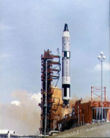
Gemini 1
Encyclopedia
Gemini 1 was the first unmanned test flight of the Gemini spacecraft in NASA
's Gemini program. Its main objectives were to test the structural integrity of the new spacecraft and modified Titan II
ICBM. It was also the first test of the new tracking and communication systems for the Gemini program and provided training for the ground support crews for the first manned missions.
The 1964 mission lasted only three orbit
s (64 orbits were completed before re-entry, but the official mission was complete after the third orbit). The spacecraft stayed attached to the second stage of the rocket and there were no plans for recovery.
measuring the pressure
, vibration
, acceleration
, temperature
, and structural loads during the short flight.
As with any new spacecraft, there were problems at first during system testings and also the rocket ran into problems, as the Air Force had yet to make the Titan II totally reliable as an ICBM, let alone as a manned launch vehicle. One instance was where a short circuit was discovered in the second stage due to the insulation being cut by a defective clamp. Several more were found with the same problem meaning that 1500 clamps had to be replaced.
 However after several months of testing the launch vehicle and spacecraft were ready for launch. Due to the hypergolic propellants used in the Titan II, the launch lacked the red flame like appearance of a Saturn
However after several months of testing the launch vehicle and spacecraft were ready for launch. Due to the hypergolic propellants used in the Titan II, the launch lacked the red flame like appearance of a Saturn
launch.
The spacecraft achieved orbit five and a half minutes after launch. The only problem found was that the launch vehicle had provided a bit too much speed and put the spacecraft into an orbit with an apogee of 320 kilometres (198.8 mi) instead of 299 kilometres (185.8 mi).
Then three orbits later the spacecraft official mission was over. There were no plans for a retrofire as the spacecraft would reenter by itself after four days. Gemini 1 remained attached to the Titan II second stage throughout the four days it spent in orbit. It was tracked by Manned Space Flight Network
until its orbit dipped too much into the atmosphere and it reentered over the South Atlantic
, midway between South America
and Africa
. The Gemini 1 mission was supported by the following U.S. Department of Defense resources: 5,176 personnel, 11 aircraft and three ships.
NASA
The National Aeronautics and Space Administration is the agency of the United States government that is responsible for the nation's civilian space program and for aeronautics and aerospace research...
's Gemini program. Its main objectives were to test the structural integrity of the new spacecraft and modified Titan II
Titan II GLV
The Titan II GLV or Gemini-Titan was an American expendable launch system derived from the Titan II missile, which was used to launch twelve Gemini missions for NASA between 1964 and 1966...
ICBM. It was also the first test of the new tracking and communication systems for the Gemini program and provided training for the ground support crews for the first manned missions.
The 1964 mission lasted only three orbit
Orbit
In physics, an orbit is the gravitationally curved path of an object around a point in space, for example the orbit of a planet around the center of a star system, such as the Solar System...
s (64 orbits were completed before re-entry, but the official mission was complete after the third orbit). The spacecraft stayed attached to the second stage of the rocket and there were no plans for recovery.
Spacecraft
Gemini Spacecraft Number 1 was built specifically for this mission. It lacked life support systems and had ballast instead. Although it featured a heat shield, the shield had four large holes drilled in it to make sure that the spacecraft was destroyed during reentry. In place of the crew couches were measuring equipment that relayed telemetryTelemetry
Telemetry is a technology that allows measurements to be made at a distance, usually via radio wave transmission and reception of the information. The word is derived from Greek roots: tele = remote, and metron = measure...
measuring the pressure
Pressure
Pressure is the force per unit area applied in a direction perpendicular to the surface of an object. Gauge pressure is the pressure relative to the local atmospheric or ambient pressure.- Definition :...
, vibration
Oscillation
Oscillation is the repetitive variation, typically in time, of some measure about a central value or between two or more different states. Familiar examples include a swinging pendulum and AC power. The term vibration is sometimes used more narrowly to mean a mechanical oscillation but sometimes...
, acceleration
Acceleration
In physics, acceleration is the rate of change of velocity with time. In one dimension, acceleration is the rate at which something speeds up or slows down. However, since velocity is a vector, acceleration describes the rate of change of both the magnitude and the direction of velocity. ...
, temperature
Temperature
Temperature is a physical property of matter that quantitatively expresses the common notions of hot and cold. Objects of low temperature are cold, while various degrees of higher temperatures are referred to as warm or hot...
, and structural loads during the short flight.
As with any new spacecraft, there were problems at first during system testings and also the rocket ran into problems, as the Air Force had yet to make the Titan II totally reliable as an ICBM, let alone as a manned launch vehicle. One instance was where a short circuit was discovered in the second stage due to the insulation being cut by a defective clamp. Several more were found with the same problem meaning that 1500 clamps had to be replaced.

Saturn (rocket family)
The Saturn family of American rocket boosters was developed by a team of mostly German rocket scientists led by Wernher von Braun to launch heavy payloads to Earth orbit and beyond. Originally proposed as a military satellite launcher, they were adopted as the launch vehicles for the Apollo moon...
launch.
Mission highlights
The first stage was jettisoned after two and a half minutes with the rocket 64 kilometers high and 91 kilometers downrange. At that moment there was an unexpected three second loss of signal from the craft. It was later determined that this brief communications blackout was caused by charged ions from the separation and startup of the second stage, similar to the blackout during spacecraft reentry. All subsequent Gemini flights would have the same brief blackout.The spacecraft achieved orbit five and a half minutes after launch. The only problem found was that the launch vehicle had provided a bit too much speed and put the spacecraft into an orbit with an apogee of 320 kilometres (198.8 mi) instead of 299 kilometres (185.8 mi).
Then three orbits later the spacecraft official mission was over. There were no plans for a retrofire as the spacecraft would reenter by itself after four days. Gemini 1 remained attached to the Titan II second stage throughout the four days it spent in orbit. It was tracked by Manned Space Flight Network
Manned Space Flight Network
The Manned Space Flight Network was a set of tracking stations built to support the American space efforts of Mercury, Gemini, Apollo and Skylab...
until its orbit dipped too much into the atmosphere and it reentered over the South Atlantic
Atlantic Ocean
The Atlantic Ocean is the second-largest of the world's oceanic divisions. With a total area of about , it covers approximately 20% of the Earth's surface and about 26% of its water surface area...
, midway between South America
South America
South America is a continent situated in the Western Hemisphere, mostly in the Southern Hemisphere, with a relatively small portion in the Northern Hemisphere. The continent is also considered a subcontinent of the Americas. It is bordered on the west by the Pacific Ocean and on the north and east...
and Africa
Africa
Africa is the world's second largest and second most populous continent, after Asia. At about 30.2 million km² including adjacent islands, it covers 6% of the Earth's total surface area and 20.4% of the total land area...
. The Gemini 1 mission was supported by the following U.S. Department of Defense resources: 5,176 personnel, 11 aircraft and three ships.
External links
- On The Shoulders of Titans: A History of Project Gemini: http://www.hq.nasa.gov/office/pao/History/SP-4203/cover.htm

